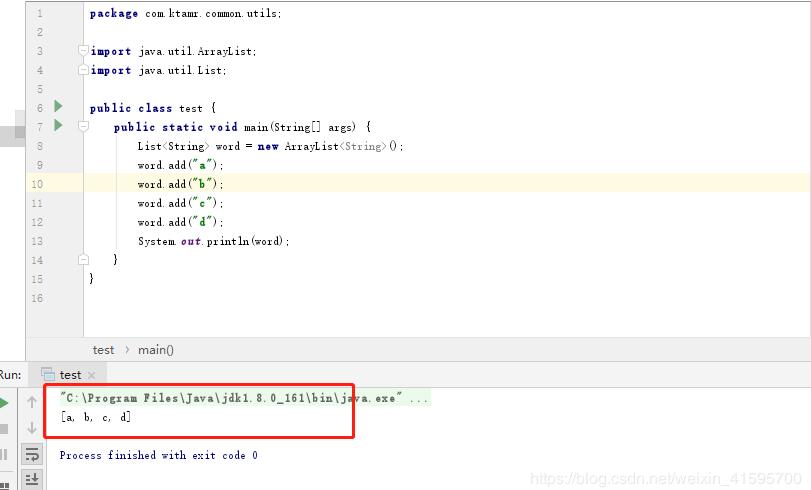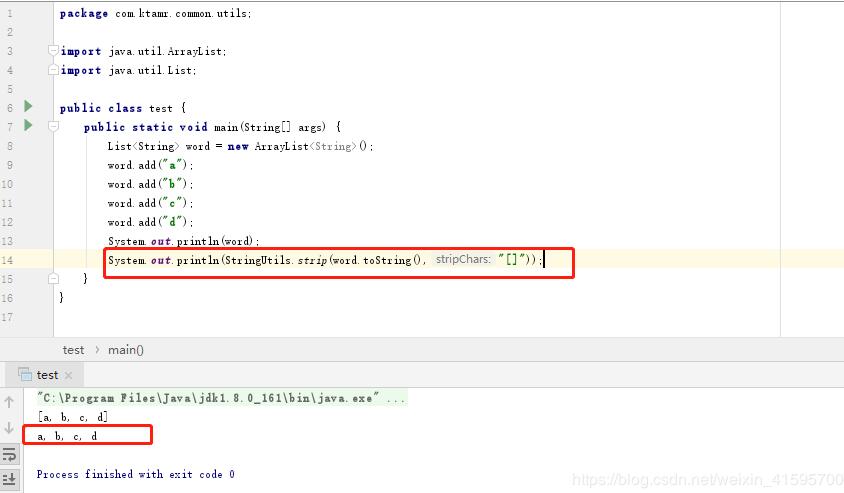Java List集合返回值去掉中括號('[ ]')的操作
如下所示:

調用StringUtils工具類的strip()方法去掉中括號'[ ]':
StringUtils.strip(word.toString(),'[]') //第一個參數放集合,第二個參數去掉中括號'[]'
StringUtils工具類代碼:

package com.ktamr.common.utils; import com.ktamr.common.core.text.StrFormatter; import java.util.Collection;import java.util.Map; /** * 字符串工具類 * * @author ktamr */public class StringUtils extends org.apache.commons.lang3.StringUtils{ /** 空字符串 */ private static final String NULLSTR = ''; /** 下劃線 */ private static final char SEPARATOR = ’_’; /** * 獲取參數不為空值 * * @param value defaultValue 要判斷的value * @return value 返回值 */ public static <T> T nvl(T value, T defaultValue) { return value != null ? value : defaultValue; } /** * * 判斷一個Collection是否為空, 包含List,Set,Queue * * @param coll 要判斷的Collection * @return true:為空 false:非空 */ public static boolean isEmpty(Collection<?> coll) { return isNull(coll) || coll.isEmpty(); } /** * * 判斷一個Collection是否非空,包含List,Set,Queue * * @param coll 要判斷的Collection * @return true:非空 false:空 */ public static boolean isNotEmpty(Collection<?> coll) { return !isEmpty(coll); } /** * * 判斷一個對象數組是否為空 * * @param objects 要判斷的對象數組 ** @return true:為空 false:非空 */ public static boolean isEmpty(Object[] objects) { return isNull(objects) || (objects.length == 0); } /** * * 判斷一個對象數組是否非空 * * @param objects 要判斷的對象數組 * @return true:非空 false:空 */ public static boolean isNotEmpty(Object[] objects) { return !isEmpty(objects); } /** * * 判斷一個Map是否為空 * * @param map 要判斷的Map * @return true:為空 false:非空 */ public static boolean isEmpty(Map<?, ?> map) { return isNull(map) || map.isEmpty(); } /** * * 判斷一個Map是否為空 * * @param map 要判斷的Map * @return true:非空 false:空 */ public static boolean isNotEmpty(Map<?, ?> map) { return !isEmpty(map); } /** * * 判斷一個字符串是否為空串 * * @param str String * @return true:為空 false:非空 */ public static boolean isEmpty(String str) { return isNull(str) || NULLSTR.equals(str.trim()); } /** * * 判斷一個字符串是否為非空串 * * @param str String * @return true:非空串 false:空串 */ public static boolean isNotEmpty(String str) { return !isEmpty(str); } /** * * 判斷一個對象是否為空 * * @param object Object * @return true:為空 false:非空 */ public static boolean isNull(Object object) { return object == null; } /** * * 判斷一個對象是否非空 * * @param object Object * @return true:非空 false:空 */ public static boolean isNotNull(Object object) { return !isNull(object); } /** * * 判斷一個對象是否是數組類型(Java基本型別的數組) * * @param object 對象 * @return true:是數組 false:不是數組 */ public static boolean isArray(Object object) { return isNotNull(object) && object.getClass().isArray(); } /** * 去空格 */ public static String trim(String str) { return (str == null ? '' : str.trim()); } /** * 截取字符串 * * @param str 字符串 * @param start 開始 * @return 結果 */ public static String substring(final String str, int start) { if (str == null) { return NULLSTR; } if (start < 0) { start = str.length() + start; } if (start < 0) { start = 0; } if (start > str.length()) { return NULLSTR; } return str.substring(start); } /** * 截取字符串 * * @param str 字符串 * @param start 開始 * @param end 結束 * @return 結果 */ public static String substring(final String str, int start, int end) { if (str == null) { return NULLSTR; } if (end < 0) { end = str.length() + end; } if (start < 0) { start = str.length() + start; } if (end > str.length()) { end = str.length(); } if (start > end) { return NULLSTR; } if (start < 0) { start = 0; } if (end < 0) { end = 0; } return str.substring(start, end); } /** * 格式化文本, {} 表示占位符<br> * 此方法只是簡單將占位符 {} 按照順序替換為參數<br> * 如果想輸出 {} 使用 轉義 { 即可,如果想輸出 {} 之前的 使用雙轉義符 即可<br> * 例:<br> * 通常使用:format('this is {} for {}', 'a', 'b') - this is a for b<br> * 轉義{}: format('this is {} for {}', 'a', 'b') - this is {} for a<br> * 轉義: format('this is {} for {}', 'a', 'b') - this is a for b<br> * * @param template 文本模板,被替換的部分用 {} 表示 * @param params 參數值 * @return 格式化后的文本 */ public static String format(String template, Object... params) { if (isEmpty(params) || isEmpty(template)) { return template; } return StrFormatter.format(template, params); } /** * 是否包含字符串 * * @param str 驗證字符串 * @param strs 字符串組 * @return 包含返回true */ public static boolean inStringIgnoreCase(String str, String... strs) { if (str != null && strs != null) { for (String s : strs) { if (str.equalsIgnoreCase(trim(s))) { return true; } } } return false; } /** * 將下劃線大寫方式命名的字符串轉換為駝峰式。如果轉換前的下劃線大寫方式命名的字符串為空,則返回空字符串。 例如:HELLO_WORLD- HelloWorld * * @param name 轉換前的下劃線大寫方式命名的字符串 * @return 轉換后的駝峰式命名的字符串 */ public static String convertToCamelCase(String name) { StringBuilder result = new StringBuilder(); // 快速檢查 if (name == null || name.isEmpty()) { // 沒必要轉換 return ''; } else if (!name.contains('_')) { // 不含下劃線,僅將首字母大寫 return name.substring(0, 1).toUpperCase() + name.substring(1); } // 用下劃線將原始字符串分割 String[] camels = name.split('_'); for (String camel : camels) { // 跳過原始字符串中開頭、結尾的下換線或雙重下劃線 if (camel.isEmpty()) { continue; } // 首字母大寫 result.append(camel.substring(0, 1).toUpperCase()); result.append(camel.substring(1).toLowerCase()); } return result.toString(); }}
補充知識:java List轉String去掉[ 、]、空格
我就廢話不多說了,大家還是直接看代碼吧~
public static void main(String[] args) { String s = '[aasa, bbbbb]'; String s1 = s.replaceAll('(?:[|null|]| +)', ''); System.out.println(s1); }
在list<String> toString后,會發現兩邊有[],且中間還有有空格產生。
解決辦法如上代碼所示,使用replaceAll正則匹配 [、]、空格。
以上這篇Java List集合返回值去掉中括號(’[ ]’)的操作就是小編分享給大家的全部內容了,希望能給大家一個參考,也希望大家多多支持好吧啦網。

 網公網安備
網公網安備